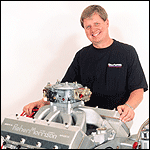 By David Reher, Reher-Morrison Racing Engines
By David Reher, Reher-Morrison Racing Engines
“If a racing part never fails, then it’s probably too big, too heavy, or too slow.”
Washing machines, refrigerators, and pickup trucks come with warranties. Race cars don’t. You can get reliability ratings on televisions, lawn mowers and bicycles from Consumer Reports. You can’t find out how reliable a racing engine is from a magazine.
There’s a fundamental difference between consumer products and racing components. Appliances, automobiles and other mass-produced durable goods are designed for longevity and low cost; race car parts are engineered for maximum performance. Dishwashers are intended to operate well within the manufacturer’s comfort zone, while race cars inevitably run on the ragged edge. So when bad things happen to good racing parts, I’m not surprised or shocked. Naturally I’m disappointed when a part fails, but I’m realistic about the demands that were made on it and the circumstances that contributed to its failure.
The harsh reality of our business is that parts are developed by the racers who use them, not by the people who manufacture and install them. Manufacturers, engine builders, and chassis builders can rely on their experience, expertise and knowledge to create better parts, but it’s ultimately the racers who do the final real-world testing and development.
If a racing part never fails, then it’s probably too big, too heavy, or too slow. It’s been said that the perfect race car is one that self-destructs 10 feet past the finish line because every component was designed to the absolute limit. Obviously that’s an extreme position, but it does point out the difference between the car that you race on the track and the car that you drive on the street. Yes, we could build racing engines that are as reliable as diesel trucks, but they would be as big and heavy as truck engines as well.
The difference between a street engine and a racing engine is like the difference between an airliner and the Space Shuttle. Jumbo jets are designed, constructed and inspected to meet established standards for passenger aircraft at reasonable cost; the Shuttles are constructed in very limited numbers at tremendous expense to endure extreme conditions. Yet despite the best efforts of thousands of people to make both airliners and Space Shuttles 100 percent reliable, bad things occasionally happen to both.
In comparison to the aircraft and aerospace industries, the racing business is a tiny niche market. There’s not enough volume in specialized racing parts to justify long-term testing programs, and there’s not enough margin in the price of components to pass along the cost of testing to the racers. Consequently a great deal of the development is done in the field.
I’m part of a generation of racers who grew up working on race cars and engines. We broke a lot of parts along the way. In fact, I’d have been disappointed if we hadn’t broken parts because that meant we weren’t pushing hard enough. That’s why I realize that a maximum-effort Top Sportsman engine won’t be as trouble-free as an engine used in a lower stress racing application.
The painful truth is that problems produce better parts. If the engine builders exceed the capacity of the available torque converters, then the transmission guys figure out how to build better, stronger converters. If the camshaft companies come up with more aggressive profiles that overtax the available valve springs, then the spring guys come up with better metallurgy and better manufacturing processes to wind better springs. That doesn’t mean that the converters and valve springs that were produced a few years or months ago were bad; it just means that the manufacturers have learned how to make their parts better.
The explosion of racing technology is both a blessing and a curse. There are so many choices and so many top-quality components on the market that mistakes are bound to happen. Think about a big-block camshaft: 10 years ago, every big-block cam was fundamentally the same. Now we’ve got different firing orders, different lifter bore spacing, different bank angles, different lifter diameters, different cam bearing diameters – not to mention thousands of different profiles. Instead of producing hundreds of identical cams, now a manufacturer has to grind virtually every cam to order. The same situation applies to pistons, rocker arms, oil pans and crankshafts. As each layer of complexity is added, the possibilities for human and mechanical errors increase.
The facts are that we will never stop having failures in racing – and that we will never stop making improvements. I’m not dismayed when bad things happen to good parts because I know that the inevitable result will be better stuff for all of us.
